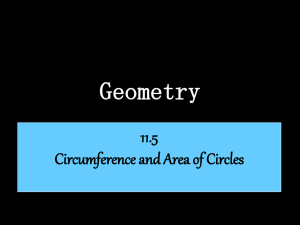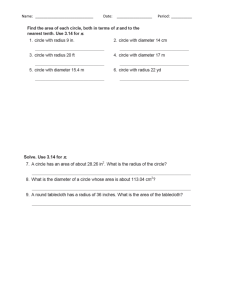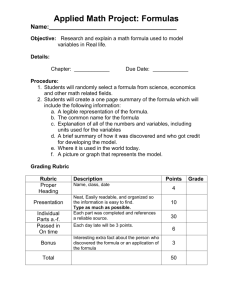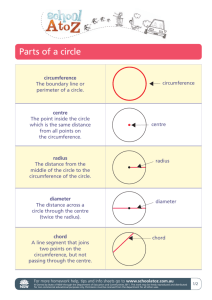Spark 101 Lesson Plan
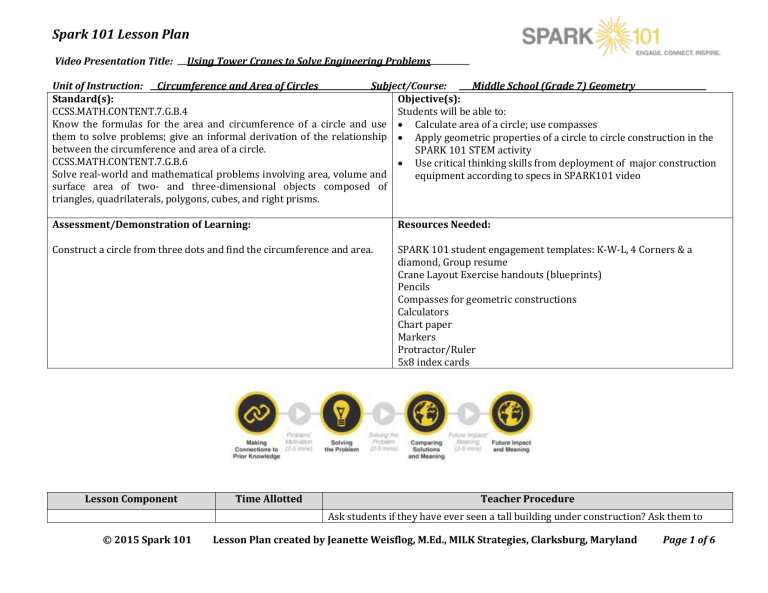
Spark 101 Lesson Plan
Video Presentation Title: Using Tower Cranes to Solve Engineering Problems
Unit of Instruction: Circumference and Area of Circles
Standard(s):
CCSS.MATH.CONTENT.7.G.B.4
Subject/Course: Middle School (Grade 7) Geometry
Objective(s):
Students will be able to:
Know the formulas for the area and circumference of a circle and use them to solve problems; give an informal derivation of the relationship between the circumference and area of a circle.
CCSS.MATH.CONTENT.7.G.B.6
Solve real-world and mathematical problems involving area, volume and surface area of two- and three-dimensional objects composed of triangles, quadrilaterals, polygons, cubes, and right prisms.
Calculate area of a circle; use compasses
Apply geometric properties of a circle to circle construction in the
SPARK 101 STEM activity
Use critical thinking skills from deployment of major construction equipment according to specs in SPARK101 video
Assessment/Demonstration of Learning:
Construct a circle from three dots and find the circumference and area.
Resources Needed:
SPARK 101 student engagement templates: K-W-L, 4 Corners & a diamond, Group resume
Crane Layout Exercise handouts (blueprints)
Pencils
Compasses for geometric constructions
Calculators
Chart paper
Markers
Protractor/Ruler
5x8 index cards
Lesson Component Time Allotted Teacher Procedure
Ask students if they have ever seen a tall building under construction? Ask them to
© 2015 Spark 101 Lesson Plan created by Jeanette Weisflog, M.Ed., MILK Strategies, Clarksburg, Maryland Page 1 of 6
Activator
(Prior to showing the video presentation)
Time:
10 minutes
Grouping:
Independent
Pairs
Small groups (3-5)
Whole group
Problem/Motivation
(Part I of video)
Time:
2-5 minutes name a few (provide examples: African American History Museum in DC)
Create a K-W-L chart on Poster Paper. Elicit responses from students by asking the question – “What do you know about Tall Building Construction?
Write the answers under the “K” column. Under the “W” column, write questions students might want to know about Tall Building Construction. Allow students to group or categorize their answers according to: needs, challenges, problems, etc.
“L” column – to be completed at the end of the lesson to determine what students learned about Building Constructions.
Concepts that could be introduced:
Sketching
CAD
3D Modeling
Designing Solutions
Identifying problems
Construction
Building Site
Measurement
Show this first segment of the video to your students, letting them know that they will be working on solving the real-world problem after viewing.
© 2015 Spark 101 Lesson Plan created by Jeanette Weisflog, M.Ed., MILK Strategies, Clarksburg, Maryland Page 2 of 6
Problem Solving
Activity
(Describe process for identifying possible solution(s) to the problem presented)
Time:
30 minutes
Grouping:
Independent
Pairs
Small groups (3-5)
Whole group
Before the groups try to solve the problem, review the geometric properties of a circle.
First assess how many students can solve a problem calculating circumference and area of a circle.
1.
The round rim of a salt shaker has a radius of 1 inch. What is the rim's diameter?
2.
Karla and Jeremy have a circular pool with a diameter of 12 feet. What is the circumference of the pool?
Based on the knowledge and skill level, review
Pi and its relationship between the circumference and diameter
Circumfere nce
Circumfere nce diameter
2 *
radius
Area of a circle
𝑨 = 𝝅𝒓
𝟐
Once students understand problems, provide practice worksheet focusing on the above calculations.
Once calculations are completed, provide notes and guidance on circle construction from three points.
CIRCLE CONSTRUCTIONS AND CALCULATIONS:
Part One: Construction
Teacher will lead students in first circle constructions
(printable instructions) http://www.mathopenref.com/print3pointcircle.html
Web animation: http://www.mathopenref.com/const3pointcircle.html
Part 2: Calculations
© 2015 Spark 101 Lesson Plan created by Jeanette Weisflog, M.Ed., MILK Strategies, Clarksburg, Maryland Page 3 of 6
Solving the Problem
(Part II of video)
Time:
2-5 minutes
Comparing Solutions and Meaning
(Describe process for identifying possible solution(s) to the problem presented)
Time:
10 minutes
Grouping:
Independent
Pairs
Small groups (3-5)
Whole group
Future Impact and
Meaning
(Part III of video)
Time:
2-5 minutes
Find the circumference and area of the above circles in centimeters. Use the protractor to measure radius. Answers should be in exact and approximate form to the hundredth decimal place. (Exact answers include “pi”; approximation must be given in specified decimal places.)
BACK TO VIDEO
Now that students have practiced construction and calculations, students will use the crane layout exercise handout and the 4 Corners and a Diamond template to work out the construction problem individually for 10 minutes. They will then share with 2-3 students in their small group. Each group will decide final design to share.
Checks for Understanding
What is the equivalent of the jib (or reach) in a circle/area circumference problem?
Show this second segment of the video to your students, letting them know that they will be comparing their solutions to the actual solution shared by the industry professional(s).
Encourage group discussion while answering the following questions:
What was the most difficult part of the constructions?
Maintaining accuracy of the
drawings, dealing with the construction instruments.
How important is accuracy in the drawings when designing a blueprint? Accuracy is
very important because errors can lead to an unsafe environment.
How important is picking the right construction equipment? The tools used for construction must fit the job; yet engineers must deploy the correct equipment to save
space, time, and cost.
Checks for Understanding
Have a spokesperson for each group share, explain, and justify their answers to these questions.
Show this third and final segment of the video to your students, letting them know that they will be reflecting on their thoughts related to pursing possible education pathways and careers presented in the video.
© 2015 Spark 101 Lesson Plan created by Jeanette Weisflog, M.Ed., MILK Strategies, Clarksburg, Maryland Page 4 of 6
Future Impact and
Meaning
(Have students reflect on how solving the problem might relate to current or future goals)
Summarizer/Closure
Assessment (if applicable)
Additional Notes (if needed)
Time:
10 minutes
Grouping:
Independent
Pairs
Small groups (3-5)
Whole group
Have the students research and compare two jobs that one could get to help service this project. - http://www.bls.gov/ooh/architecture-and-engineering/civilengineers.htm#tab-8
The student will use the Spark 101: Group Resume Template to complete the assignment.
Checks for Understanding
Time:
5 minutes
Have students discuss related STEM pathways they might be motivated to pursue and the related Education, Skill set, Job Outlook, Earnings, “Day in the Life”, etc
Today’s class allowed students to apply the basic geometric properties of a circle to a real world application. The most important goal of this activity is to allow students to think outside the box, make errors due to lack of clarity, etc., and possibly fail.
Sometimes failure is the best experience; students will know what does not work and try another solution. Also, they will understand that accuracy and precision is very important when it comes to constructions and safety on small and large-scale projects.
Pass out 5x8 notecards. As an exit ticket, have each scholar make three points on the note card to construct a circle and find the circumference and area of the circle.
CK12 Connections (if available) OpenStax Connections (if available)
© 2015 Spark 101 Lesson Plan created by Jeanette Weisflog, M.Ed., MILK Strategies, Clarksburg, Maryland Page 5 of 6
Four Corners and a Diamond -
This video highlights Clark Construction’s effort to use tower cranes to build the African American History Museum in Washington, DC. Using the diagram below:
1.
State the problem in the diamond at the center.
2.
Organize your thoughts by listing what you already know about the problem associated with the topic.
3.
Write the constraints and limitations related to solving the problem.
4.
List some workable solutions. Watch the rest of the video.
5.
Use the last corner to consider how this real-life problem might relate to your college and work goals.
© 2015 Spark 101 Lesson Plan created by Jeanette Weisflog, M.Ed., MILK Strategies, Clarksburg, Maryland Page 6 of 6

